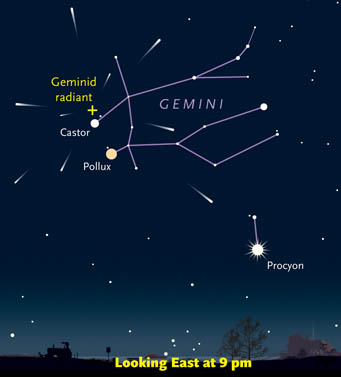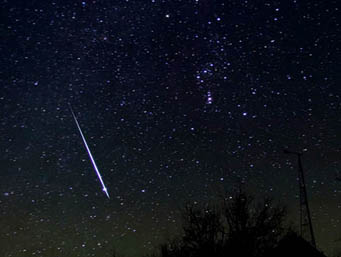UPDATE, Dec. 15: The shower seems to have peaked on schedule in the first half of December 14th Universal Time. Keep watch on its declining activity in the next few days.
UPDATE, Dec. 13: Early this morning observers were already counting 40 Geminids per hour under ideal conditions, according to the International Meteor Organization (IMO). See the IMO's graph of the shower's behavior, based on careful standardized-method amateur counts being reported from around the world.

The radiant (apparent source point) of the Geminid meteor shower is near Castor, the fainter of the Twin Stars in the constellation Gemini. You'll see this view if you face east at about 9 p.m. (The number of meteors is exaggerated.)
Sky & Telescope illustration
Mention "meteors," and casual skywatchers usually think of the annual Perseid shower on display every August.
But the Geminid meteor shower of mid-December ties or even surpasses the Perseids as the year's richest and most reliable meteor display. Geminid meteors come from 3200 Phaethon, an asteroid discovered in 1983.
This year the Geminids are predicted to peak on the morning of December 14th around 11h UT, more or less. That's excellent timing for North America, especially out West. The Moon that night is only a day past first quarter and sets around midnight or 1 a.m. local time, depending on where you live. Even before then, on the evening of the 13th, the moonlight isn't bright enough to dampen the shower's visibility too much — and the Geminids, with their radiant near Castor and Pollux, pick up steam as early as 8 or 9 p.m. But the radiant is highest around 2 a.m., so the morning hours are the usually the most productive.
Bundle up as warmly as you possibly can, and lie back in a dark spot with an open sky. You may see as many as two meteors a minute on average if you have a very dark sky and are watching after midnight.

During the 2004 Geminid meteor shower, Alan Dyer caught a bright fireball with a tripod-mounted digital camera. He used a wide-field, 16-mm lens for a 1-minute exposure at f/2.8 with an ISO setting of 800. Expect to shoot a lot of frames before you get this lucky. Click image for larger view.
Alan Dyer
If your sky is not too light-polluted, you might try making a careful meteor count and reporting it to the International Meteor Organization. Such counts by amateurs supply much of what we know about meteor showers' behavior. For your count to be useful, you'll need to follow the procedures described on our page or at the IMO's website.
Don't forget that the shower lasts more than one night. Counts are especially needed on nights away from the maximum, because fewer people are watching. In any case, enjoy the show!
 10
10









Comments
NTS
December 13, 2010 at 7:49 pm
Watched the Geminids from my townhome near Honolulu from about 11:30 PM to midnight on 12/12. Saw about 10 meteors in that time. With all the building lights it was hard to get dark adapted, and I could only see a fairly narrow band of sky, so my conditions are far from the ideal! Still worth it though. Weather and time permitting I plan to watch again tonight.
You must be logged in to post a comment.
TexToast
December 13, 2010 at 8:09 pm
On Sunday looked towards Orion's belt and saw one streak across. That was around 7.45pm Central. Looking forward to tonight.
You must be logged in to post a comment.
TexToast
December 13, 2010 at 9:54 pm
Tonight between 9.40 and 10.30pm Central, saw about 12 streak across. Saw most around Orion's belt.
You must be logged in to post a comment.
TexToast
December 14, 2010 at 3:36 am
Live in Dallas-Fort Worth area, between 3.15am and 4.15am saw about 21 in various directions. Unfortunately too light out here, otherwise I would have seen more.
You must be logged in to post a comment.
Steve
December 14, 2010 at 5:56 am
Awesome night! Braved 19°F cold and 20 mph winds but saw dozens of meteors. Captured about a dozen of those on camera. The best posted in this set: http://www.flickr.com/photos/stephen_little/sets/72157625470961355/
You must be logged in to post a comment.
Gene Osegovic
December 14, 2010 at 6:28 am
Greetings! I observed from 0250 to 0350 MT on the morning of December 14th from a suburban location in Monument, Colorado, elevation 7000 feet MSL, limiting magnitude estimated at 5.5. The sky condition was mostly clear.
The radiant of the Geminid shower was hidden behind a house, so I only kept a total count of all meteors seen, counting 54. Most of the observed meteors were visual magnitude 2 or 3, with a handful between 1 and -1, and a couple of magnitude 4. The brightest meteor, magnitude -1, was bluish-white and left a short-lived train, the only train noted during the observing session. The highest meteor frequency was five in one minute.
You must be logged in to post a comment.
Our Fathers Heart
December 14, 2010 at 8:43 am
good morning. We were up watching the sky between 1:45 a.m. and 3:00 a.m. (EST) this morning in Loganville, GA and we saw about 30 meteors - some around Orion's belt, most were near Castor. It was oh, sooooo cold, but oh, soooo cool! Well worth it especially since we are studying about space rocks since last week. 🙂
You must be logged in to post a comment.
Our Fathers Heart
December 14, 2010 at 8:43 am
good morning. We were up watching the sky between 1:45 a.m. and 3:00 a.m. (EST) this morning in Loganville, GA and we saw about 30 meteors - some around Orion's belt, most were near Castor. It was oh, sooooo cold, but oh, soooo cool! Well worth it especially since we are studying about space rocks since last week. 🙂
You must be logged in to post a comment.
Lydia
December 14, 2010 at 11:01 am
I watched from 9 pm MST until 11:30 pm here in Arizona on 12/13. I saw 35 the first hour and 42 the second hour. What a show!
You must be logged in to post a comment.
Wayne
December 15, 2010 at 11:25 am
I was out watching the morning of the 13th and 14th from 3am till 4:30am both days.On the 13th I saw 15 with 2 being real barn burners. The tail lasted a full 2 seconds with pieces breaking off the head. On the 14th there were over 30 in the nearly two hours I watched. Three separate times I had two meteors in the same minute. The sky was exceptionally clear. This was the best show I have seen since moving here to Bullhead City AZ.
You must be logged in to post a comment.
You must be logged in to post a comment.